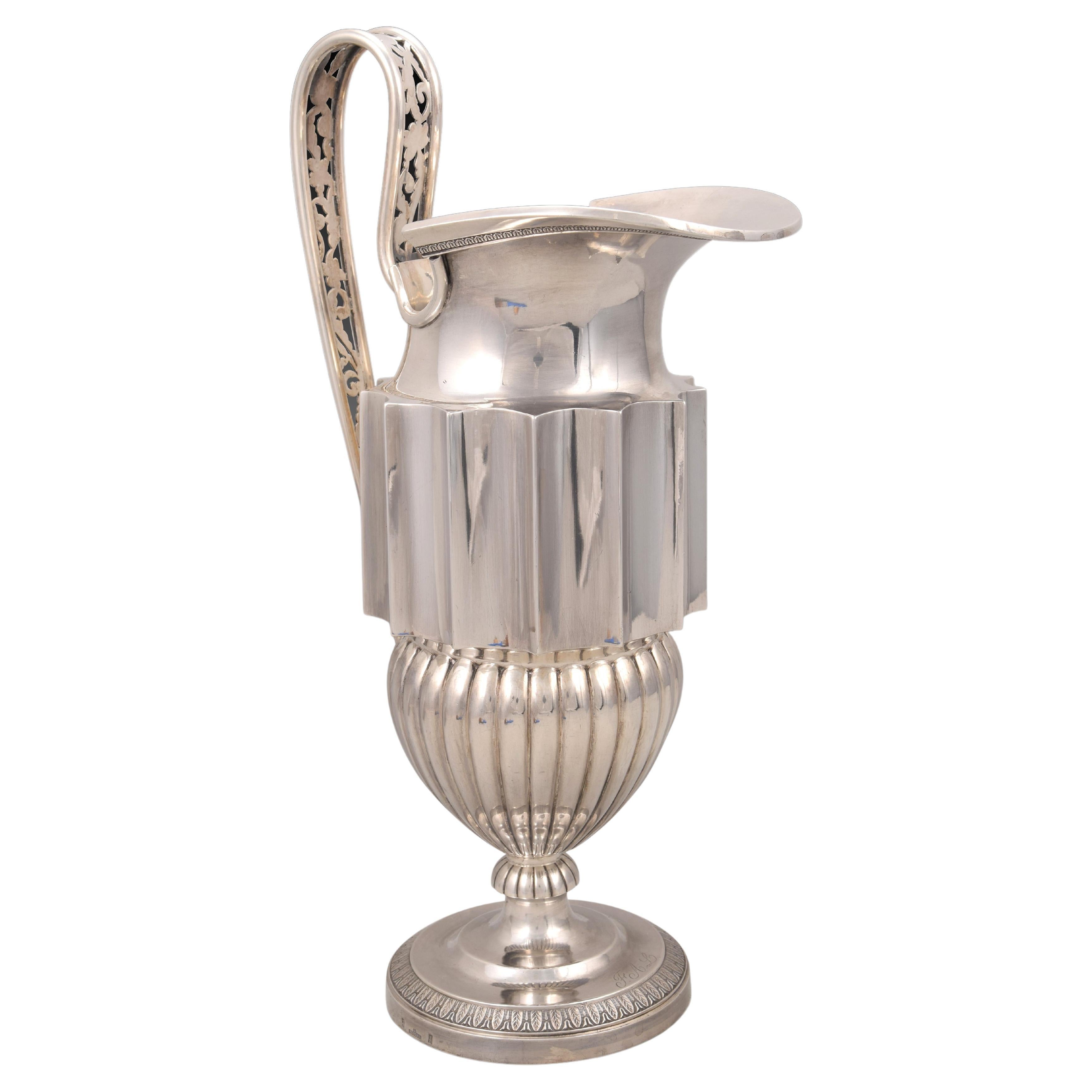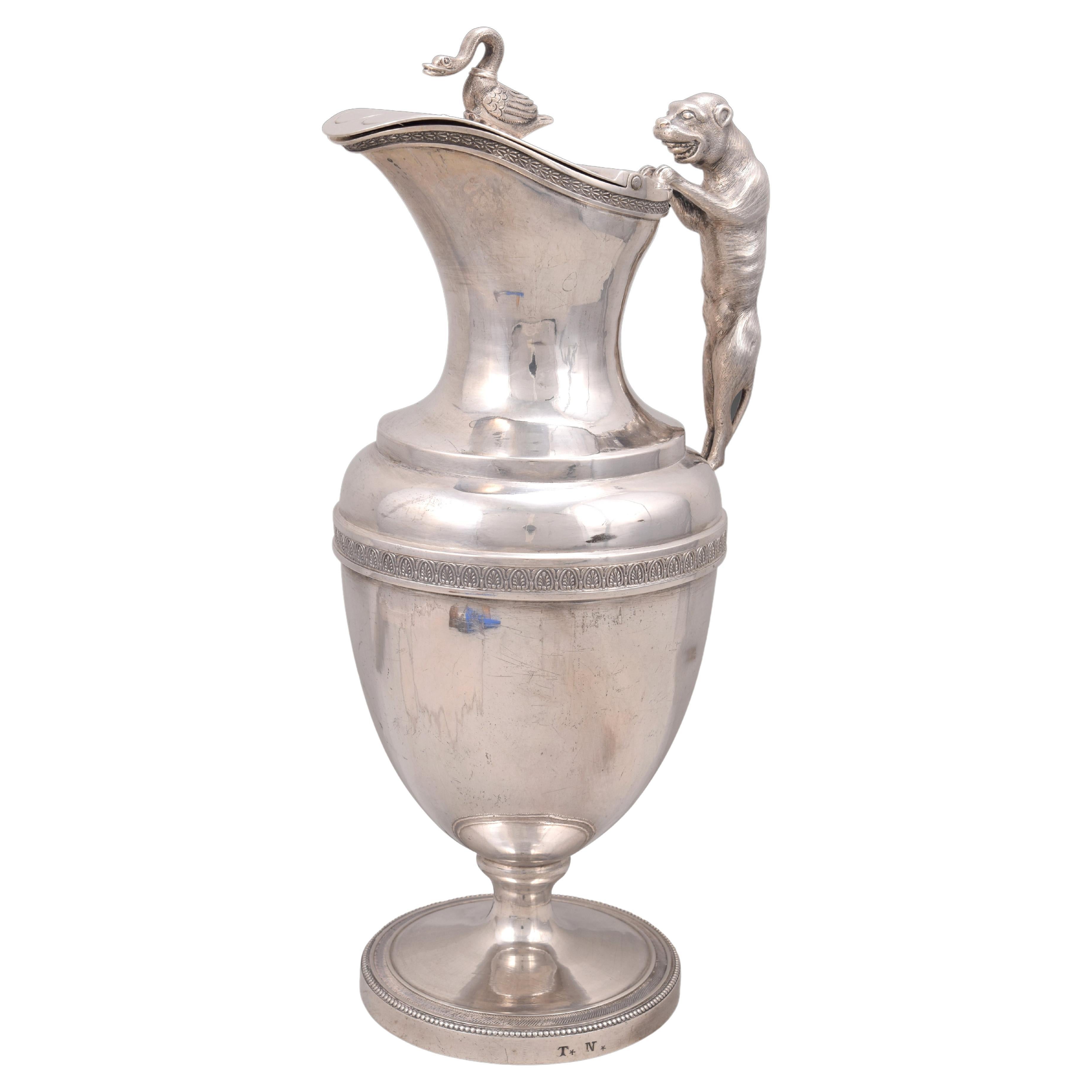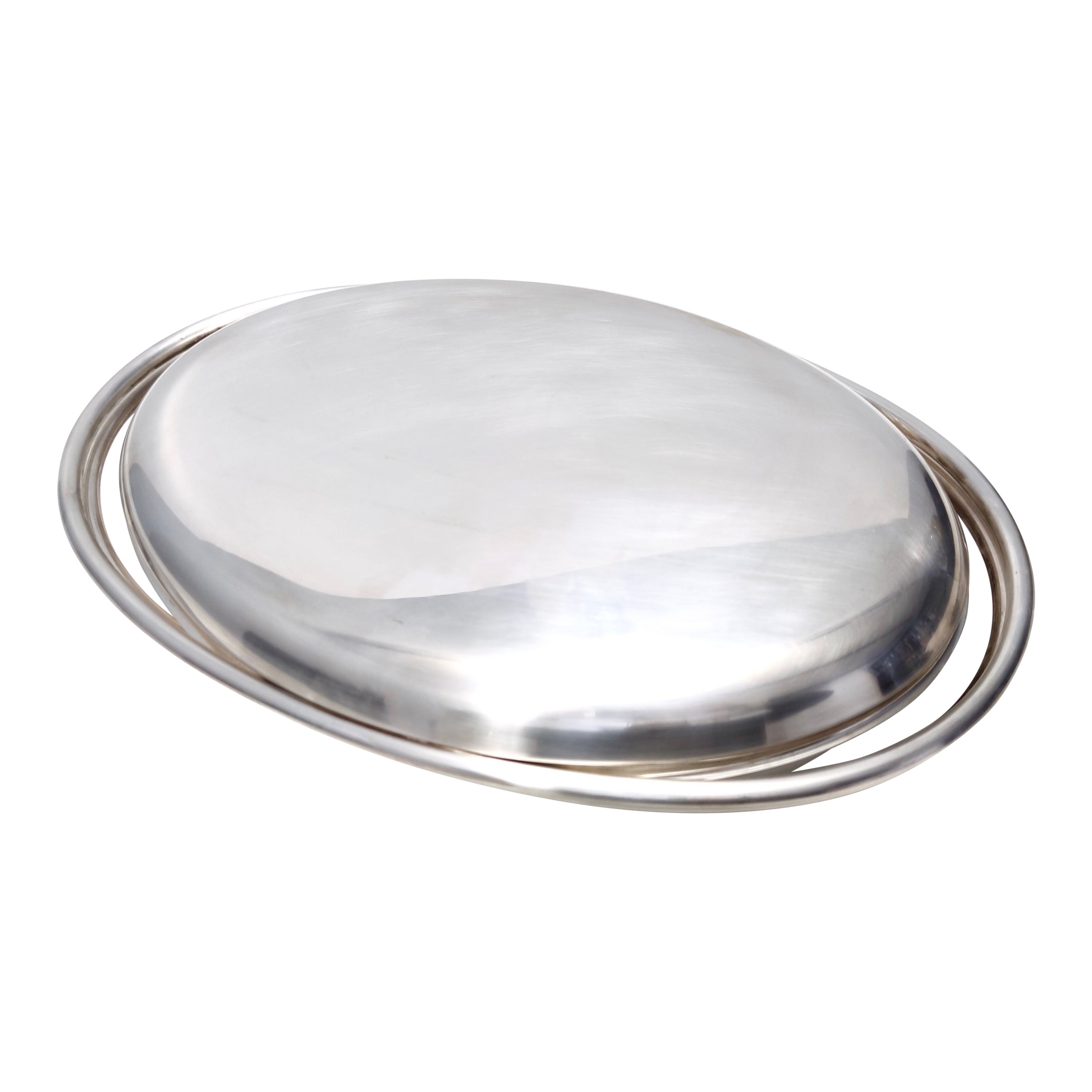Items Similar to Jug, Silver, Faxardo, Antonio, Spain, Cadiz, 1787, Marked Also in Italy 'Naples'
Want more images or videos?
Request additional images or videos from the seller
1 of 11
Jug, Silver, Faxardo, Antonio, Spain, Cadiz, 1787, Marked Also in Italy 'Naples'
About the Item
Jug. Silver. FAXARDO, Antonio. Spain, Cadiz, 1787; highlighted in Italy (Naples).
With contrasting and burilada marks.
Published in Encyclopedia of Spanish and Viceregal American Silver. Bibliography: Fernández, Alejandro; Munoa, Raphael; Rabasco, Jorge. "Encyclopedia of Spanish and Viceregal American Silver". Second edition, corrected and enlarged. Torreangulo Graphic Art, Madrid, 1985. Page 121; image 235 on page 331.
Silver jug in its color that has a raised circular foot, a spherical body that narrows upwards and opens again towards the lid of the piece (which has an open spout, simple engraved decoration and a plant finish of branches with fruit) , and a curved handle decorated with architectural and vegetal elements of clear classicist inspiration. This same influence can be clearly seen in the lines of the piece. Typologically, it falls within a common line of 18th-century Neoclassical Spanish silverware that emerged in the capital of the Court (Madrid), a city from which it spread to other centers. Likewise, a certain memory of the Rococo is usually mentioned in some detail (the handle in the present case). The contrasting marks that it presents are those of the town of Cádiz, that of the silversmith Antonio Faxardo (active between 1775 and 1789), a chronological mark (1787) and that of Naples (considered as a remarca). Note that the Cadiz hallmark, the contrast hallmark (illegible), the chronology hallmark (1786) and the silversmith Antonio Faxardo's hallmark appear on a chalice in Santander Cathedral. In the aforementioned book they identify the marks present on the piece, in addition to providing a photograph of it.
Weight: 1008 grams. Size: 17x13x30 cms.
International Buyers – Please Note: for those articles that need Export Permits (those older than 100 years), the obtaining of the Permit will be processed without additional expenses (if you choose the seller sends it to you), but the period for the obtention of it may vary from 10 to 35 days.
- Creator:Spanish Manufactory (Artist)
- Dimensions:Height: 11.82 in (30 cm)Width: 6.7 in (17 cm)Depth: 5.12 in (13 cm)
- Style:Rococo (Of the Period)
- Materials and Techniques:
- Place of Origin:
- Period:1780-1789
- Date of Manufacture:1787
- Condition:Wear consistent with age and use. Minor losses. Minor fading.
- Seller Location:Madrid, ES
- Reference Number:
About the Seller
4.9
Vetted Seller
These experienced sellers undergo a comprehensive evaluation by our team of in-house experts.
Established in 1985
1stDibs seller since 2017
292 sales on 1stDibs
Typical response time: 1 to 2 days
- ShippingRetrieving quote...Ships From: MADRID, Spain
- Return PolicyThis item cannot be returned.
More From This SellerView All
- Silver Jar or Jug, De San Faurí, Juan, Spain, Madrid, 18th CenturyBy Spanish ManufactoryLocated in Madrid, ESJug or jug. Silver. DE SAN FAURÍ, Juan (1745-1785). Spain, Madrid, towards the last third of the 18th century. With contrast and burilada marks, and property name (Ochoa). The jug has an oval base with slight curves and a body divided into two areas (wider in the lower half, slightly concave in the upper half) with a series of curved “gajos”; the peak shows simple architectural decoration and smooth areas; the handle is of a type known as brace, with classicist architectural elements; the lid follows the lines of the body and is finished off with a vegetable shape creating a knob. On one of the sides, towards the foot, there is the engraved text "Ochoa", referring to a former owner. Contrasting marks place the creation of the piece in Madrid. Another one that appears could be one of those used by the silversmith Juan de San Faurí. With Felipe V, numerous French influences, along with some Italian ones, came to silverware, both from the hand of craftsmen of these origins and from pieces. Little marking continues in the works, except in important centers such as Madrid, and civil typologies acquired great importance. As in the rest of the country, the Baroque, Rococo and Neoclassical tendencies coexisted at the Court, although, being the center that set the standard for the rest, the former soon departed, introducing Rococo before 1740 or on that date, and Neoclassicism around 1770 (gradually imposing itself from 1780). The jug follows the most common prototype since the arrival of the Bourbons, characterized by its European influence and the great difference it shows with the type known as the “spout jug”. Compare with the Francisco García...Category
Antique Late 18th Century Spanish Neoclassical Serving Pieces
MaterialsSilver
- Jug or Jar, Silver, Madrid, Spain, 1803Located in Madrid, ESJug. Silver. Madrid, Spain, 1803. With contrast markings. Published Encyclopedia of Spanish and Viceregal American silver. Bibliography: Fernández, Alejandro; Munoa, Raphael; Rabas...Category
Antique Early 1800s Spanish Neoclassical Jars
MaterialsSilver
- Jug or Jar, Silver, Sellan, Juan. Madrid, 1847By Juan SellánLocated in Madrid, ESJug. Silver. SELLAN, Juan. Madrid, 1847. With contrast markings. Silver pitcher in its color that has a flat handle decorated with simple openwork plant elements between two smoo...Category
Antique 1840s Spanish Neoclassical Serving Pieces
MaterialsSilver
- Jug. Silver. Vitoria, 18th-19th CenturiesLocated in Madrid, ESJug. Silver. Vitoria, 18th-19th centuries. With contrasting and burilated marks, and property initials (TN). Published in Encyclopedia of Spanish and Viceregal American Silver. Bibliography: Fernández, Alejandro; Munoa, Raphael; Rabasco, Jorge. "Encyclopedia of Spanish and Viceregal American Silver". Second edition, corrected and enlarged. Torreangulo Graphic Art, Madrid, 1985. Page 240; page 430, image 1472. Jug or pitcher of silver in its color, with a circular foot decorated with moldings and a string of pearls, semi-ovate belly on which, by means of a band of classicist architectural motifs, a curve, a step and a high neck with a concave profile rise. The mouth, with a sinuous outline and enhanced with another band of plant elements, presents an elevation towards the spout, and covers with a cap or lid topped with a swan-shaped knob. The handle is a feline with a round shape, in an attitude of stalking towards the bird. Typologically, the piece follows neoclassical models, brought from Europe to Madrid and spread from this place. Likewise, it should be noted that the handle with a figurative element of a round shape is not entirely common, although there are known examples in private collections of jars...Category
Antique 19th Century Spanish Neoclassical Serving Pieces
MaterialsSilver
- Silver Jug with Illegible Hallmarks, 18th CenturyLocated in Madrid, ESJug with lid and silver handle in its color that has a circular foot decorated and raised with a series of moldings and a band of pearls, from which part a small foot that gives way ...Category
Antique 18th Century European Rococo Serving Pieces
MaterialsSilver
- Silver Fruit Tray or Tray, Córdoba, Bartolomé Gálvez y Aranda, 1759-1768, SpainBy Bartolomé Gálvez y ArandaLocated in Madrid, ESSalva cordobesa in silver, 1759-1768. With brands. Córdoba, Spain. Weight: 820 g. Salva in silver Rococo style, with punches of Cordoba and the score Bartolomé Gálvez y Aranda. It has a high, stepped foot, with a circular base, adorned with incised streaks and other simple motifs of a Classic type, announcing the change of language towards Neoclassicism. However, the dish itself is still distinctly Rococo, with a profile of curved mitering that translates into edges in the eaves. Bartolomé Gálvez y Aranda was a silversmith, although he worked as a marker between 1759 and 1772, using for this work the punch that we see here: his surname in capital letters, in very trapezoidal frame and surmounted by a fleur-de-lys in three-lobed projection. To this punch Gálvez y Aranda will add since 1768 the chronological mark, so this salvo would be dated between 1759 and 1768. It is also an especially interesting piece to come from Cordoba, the main center of Spanish silverware of the Rococo period, from whose workshops came religious and profane pieces of high quality, aimed at customers not only local but throughout the Iberian Peninsula, reaching even the Canary Islands and Latin America. The great diffusion of the Cordovan silversmith will take place, in fact, in the last quarter of the 18th century, through the so-called master silversmiths. These characters acted as trade corridors, according to Pérez Grande, visiting the churches and fairs held throughout the country. The activity of these silversmiths was also favored by tax exemptions...Category
Antique Mid-18th Century Spanish Rococo Serving Pieces
MaterialsSilver
You May Also Like
- Spanish Brass Jug Decorated with Embossed Skirt on the TopLocated in Marbella, ESSpanish brass jug decorated with embossed skirt on the top.Category
Early 20th Century Spanish Serving Pieces
MaterialsCopper
- Postmodern Lino Sabattini Silver-Plated Metal Serving Plate, Marked, ItalyBy Lino SabattiniLocated in Bresso, LombardyMade in Italy, 1970s - 1980s. This is a great silver plated metal serving dish. Its simple design was created by Lino Sabattini. This is a vintage piece, therefore it might show sli...Category
Vintage 1970s Italian Post-Modern Serving Pieces
MaterialsMetal, Silver Plate
- Italian Modern Silver Platinum White Majolica Crown Vase with Orange Green DotsBy Cosulich Interiors & AntiquesLocated in New York, NYContemporary handmade Italian Work of Art, a decorative vase in the shape of a crown in majolica, exclusive for Cosulich Interiors & Antiques by Ceramica Gatti, a long tradition Stud...Category
2010s Italian Art Deco Vases
MaterialsPlatinum, Enamel
- Spanish Handmade Brass Pitcher with Handle for KitchenLocated in Marbella, ESSpanish handmade brass pitcher with handle for kitchen.Category
Early 20th Century Serving Pieces
MaterialsCopper
- Amélie Handcrafted Sugar Bowl, Handmade in Italy 2021, Choose Size and ColorsBy Mosche BiancheLocated in San Miniato PI, ITThis wonderful collection encourages to participate in the process of combining small pleasures into a significant whole by regarding details as both minute and essential. Our artist...Category
2010s Italian Modern Serving Pieces
MaterialsCeramic
- Victorian Silver Plated Serving Dish with Hot Water SpaceLocated in Sheffield, MAThe Victorian silver plated and footed serving dish has space below the metal grill for holding hot water to keep food warm for a longer period of time. The metal would also retain h...Category
Antique Mid-19th Century English High Victorian Serving Pieces
MaterialsSilver Plate
Recently Viewed
View AllMore Ways To Browse
Spanish Colonial Sideboard Or Buffett
Spain Spanish
Antique Spanish
Antique Spain
Spanish Antique
Antique Spanish Furniture Furniture
Antique Spanish Furniture
Antique Furniture Spanish
Spanish Antique Furniture
Spanish Furniture Antique
Spanish Antique Furniture Spanish Antique Furniture
Furniture From Spain
Antique In Spanish
Old Spanish
Antique Furniture From Spain
Spanish 18th
Spain Silver
Silver From Spain





